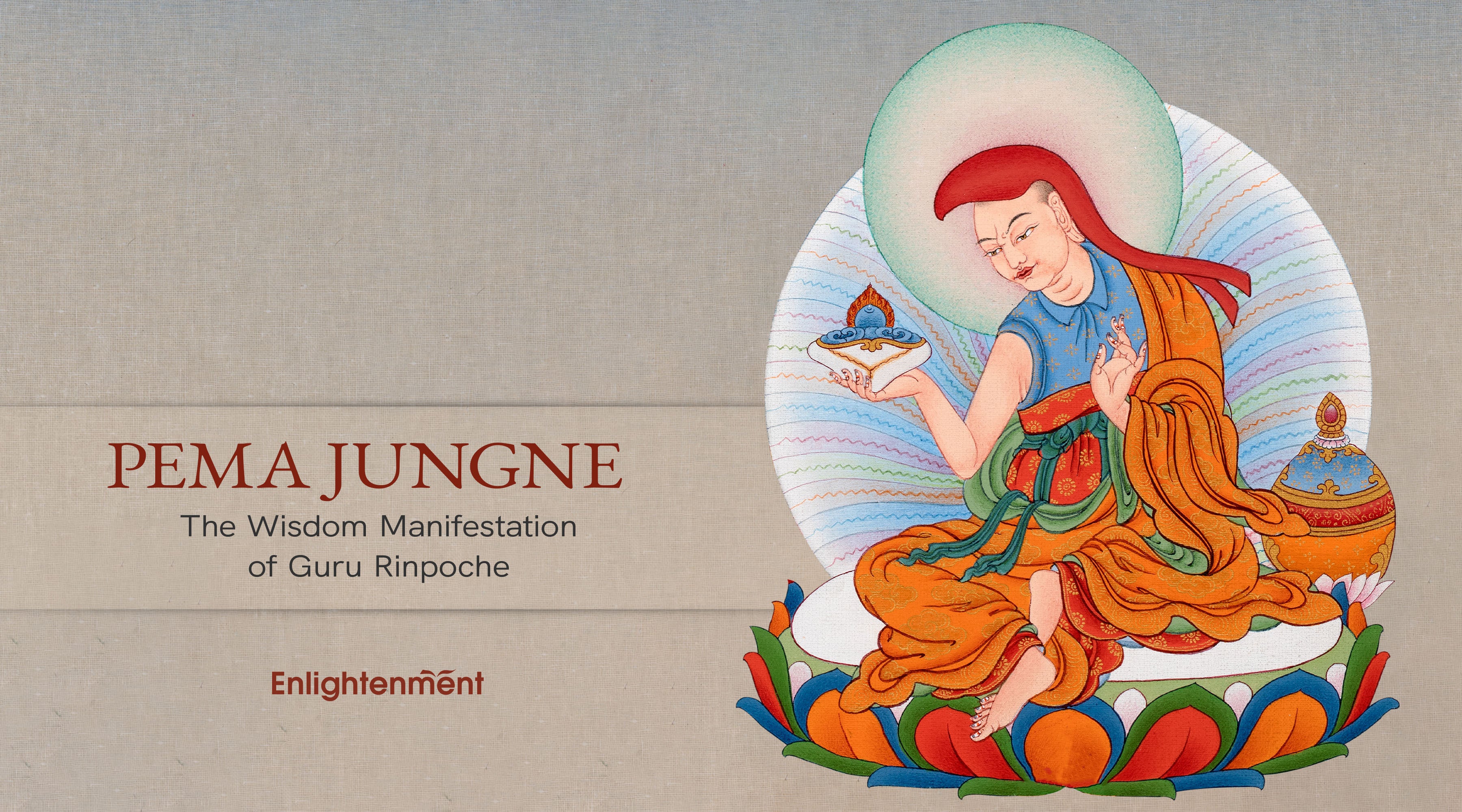Pema Jungne Embodies Monastic and Wisdom Qualities
Pema Jungne is the master and protector of Dharma as another monk form of Guru Rinpoche. Also known as the Second Buddha, Guru Rinpoche is more than just a historical teacher; he is revered as an enlightened being who transcends time and space. Hence, he manifested in various forms to meet the needs of different beings and situations.
A being born miraculously from a lotus flower on Lake Dhanakosha in the Oddiyana region, he was bound to restore peace and Dharma. Each of his eight forms headed his mission: to bring the esoteric teachings of Vajrayana Buddhism to Tibet. Guru Jungne holds no exception except for his ways for the involvement of his teachings on compassion, wisdom, and skillful means. Thus, his spiritual journey marks a transformative era in Vajrayana history.
Guru Padmasambhava, or Guru Rinpoche, is pivotal in Tibetan Buddhism as both a historical and spiritual figure. Moreover, the tales of his eight manifestation forms make up the equally deified part among the devotees. The following list includes the total forms of the Sangye Yeshe:
- Shakya Senge
- Pema Gyalpo
- Nyima Odzer
- Dorje Drolo
- Senge Dradog
- Lodan Chokse
- Pema Jungne
- Urgyan Dorje Chang

Guru Pema Jungne Origin Story
One legend goes like this: once, Guru Pema Jungne made his way through Magadha, a place in Zahor. The place was the home of a very large and sinister cemetery named Selva Tsel. The wise and fearless guru wished to practice his spiritual duties there, so he started residing in the cemetery, albeit his pious and monastic milieu.
With time, the pious being performed the most precious tantric prayer and gained the knowledge of the twelve pitakas, named sdi snod bchu gnes. Thus, started his journey as a highly venerated Guru where he took on several disciples. These disciples, known as Rigzins, did their best in serving their master but also propagating Dharma.
The Iconography of Pema Jungne
Guru Pema Jungne is depicted in Himalayan arts and crafts as a highly worshipped deity. His depiction is particularly rich and diverse, reflecting his multifaceted roles and qualities. The most noticeable parts about him are explained below:
1. Relaxed Facial Expression and Posture
As an ordained monk and the teacher of Dharma, Guru Padmasambhava is portrayed in a relaxed manner. He is mainly depicted to be seated in a relaxed position, with his right leg slightly stretched before him. He sits on a double cushion that rests upon a gold-embellished throne. His facial expression adds another highlight where he appears to be in a light temper, an expression befitting a divine being.
2. Nectar Skull Cup in Right Hand
The venerated Guru holds a skull cup filled with nectar in his right hand that symbolizes his profound spiritual transformation and the ultimate attainment of enlightenment. Meanwhile, he performs the mudra of explication (Vitaraka Mudra) with the left. In addition to this, there is a wooden storage jar near to him, among his artefacts.
3. Monk Attire
Guru Jungne's attire is that of a monk; hence, he wears a yellow-orange monk robe. The robe is wrapped gracefully around his body while it flows gracefully along his feet. However, the blue inner vest is the most distinguishable part of him in the arts.
4. Pandita Hat
The most distinctive representation of Pema Jugne is his Pandita hat. Though the color might differ according to the artist, the hat is not a miss in his art. Unlike other monk hats, his Pandita hat rests flat on his head instead of pointing upwards.
5. Disciples Around Him
It is believed that Guru Pema Jungne had accumulated twenty-five devoted disciples during his residence at Selva Tsel cemetery. Meanwhile, four of them became the most notable ones due to their miraculous feats. As a result, they have become a part of Guru Jungne's art depictions. From the apex anti-clockwise, Yeshey Yang sits with the wonderous feat of being able to visit celestial realms. This ability is named the power of Kha cho.
Khonchok Jugney is next in the line who has the ability to summon upon violent thunderstorms at will.

The third Rigzin is the respected King Thrisong Detsen. He is a widely known name among the Vajrayana worshippers as he was the one who invited Guru Rinpoche to disseminate Buddhism in Tibet. He did so under the suggestion of another revered Buddhist master, Shantarakshita. King Detsen was born to King Tridhe Tsukten and Queen Kongjo in Drakmar Hombu.
The fourth Rigzin, Dorji Dujom is said to have acquired the swiftness of the wind. Therefore, he is depicted amidst a gust of wind.
In addition to such divine beings surrounding Guru Jungne, there is also a devout goddess tending to him. She offers a blooming lotus to her lord. Similarly, the background incorporating such radiant beings is that of the Selva Tsel cemetery. It is to symbolize the Guru's time there while the rich floral backdrop is also another point to be noticed.
Despite the cemetery visuals, the flowers play an important part to showcase Guru Jungne's wise and compassionate side. Hence, the cemetery and floral visions blends harmoniously in support of color contrast in a single painting.
Pema Jungne in Contemporary Buddhist Practice
Guru Pema Jungne remains an important and venerated figure in Vajrayana Buddhism as a part of Guru Rinpoche's eight manifestations. His teachings emphasize the importance of wisdom, Buddhist teachings, and compassion to overcome ignorance and evil forces. His presence continues to exert a profound influence on contemporary Buddhist practice. As a monk and wise manifestation of the enlightened master who brought Vajrayana Buddhism to the Himalayas, Guru Jungne is revered for his ability to guide practitioners toward enlightenment.


